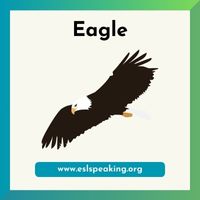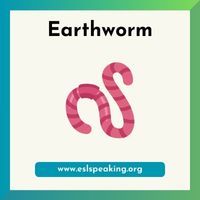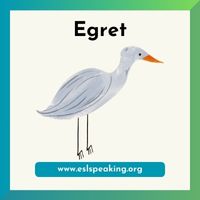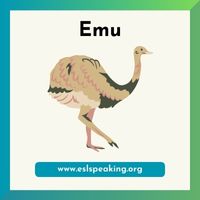Are you looking for a list of animals beginning with E? If yes, you’re at the right place! We have a list of animal names that start with the letter E. Our animal list comes with pictures and descriptions to help your research or learning.
List of Animals that Start with the Letter E
These are the animal names that begin with the letter E that will be discussed in this article:
- Elephant
- Elk
- Earthworm
- Elephant seal
- Eel
- Egret
- Egyptian Mau
- Eagle
- Emu
- Emperor Penguin
- Earwig
- Eastern Coral Snake
- Eastern Box Turtle
- Echidna
- Ermine
- Eastern Gorilla
- Evening Bat
- English Bulldog
- Elf Owl
- Emperor Angelfish
Animals that Start with the Letter E
Check out the “E” animal list with pictures.

Eagles:
- Large birds of prey.
- Impressive wingspans, sharp beaks, and strong talons.
Habitat and Behavior of Eagles:
- Live in various places like mountains and forests.
- Excellent hunters with keen eyesight, often soaring high in the sky.
Symbolism and Protection of Eagles:
- Symbol of freedom and strength in many cultures.
- Some types of eagles need help to protect their homes, and people are working to keep them safe.

Earthworms:
- Small, slimy creatures found in soil.
- Important for gardens as they help plants grow by loosening the soil.
Physical Characteristics and Behavior of Earthworms:
- Long, cylindrical bodies without legs.
- Wiggle and burrow through the soil, eating organic matter.
Benefits and Importance of Earthworms:
- Improve soil structure by creating channels for air and water.
- Recycle nutrients in the soil, making it healthier for plants.

Earwigs:
- Small insects with long bodies and pincers on their back.
- Mostly active at night and like hiding in dark, damp places.
Physical Characteristics and Behavior of Earwigs:
- Long, slender bodies with pincers at the end.
- Use pincers for defense and capturing prey.
Habitat and Diet of Earwigs:
- Found in gardens, under rocks, and in other hidden spots.
- Eat insects, plants, and sometimes decaying matter.

Eastern Box Turtle:
- Small turtles with a unique domed shell that can close like a box.
- Colors vary, with distinctive yellow or orange markings on the shell.
Habitat and Behavior of Eastern Box Turtles:
- Found in forests, meadows, and gardens with a mix of woods.
- Move slowly and enjoy basking in the sun.
Protection and Lifespan of Eastern Box Turtles:
- Can pull head, legs, and tail inside the shell for protection.
- Live a long time, with some reaching over 100 years in age.

Eastern Coral Snake:
- Colourful snake with bright bands of red, yellow, and black.
- Small in size and slender, often mistaken for non-venomous snakes.
Venom and Defense of Eastern Coral Snakes:
- Has venom, but rarely poses a threat to humans as it’s shy and reclusive.
- Uses its color pattern as a warning, and its bite can be harmful.
Habitat and Diet of Eastern Coral Snakes:
- Found in forests and sandy areas in the southeastern United States.
- Feeds on smaller snakes, lizards, and sometimes amphibians.

Eastern Gorilla:
- Large, powerful primates with dark fur and distinctive faces.
- They are herbivores, mainly eating plants, fruits, and leaves.
Habitat and Family of Eastern Gorillas:
- Native to forests in Central and East Africa.
- Live in family groups led by a dominant male, called a silverback.
Conservation and Importance of Eastern Gorillas:
- Facing threats like habitat loss and poaching.
- Important for maintaining biodiversity, and conservation efforts are in place to protect them.

Echidna:
- Unique mammals with spiky spines and long snouts.
- Lay eggs and are one of the only monotremes, like platypuses.
Physical Characteristics and Behavior of echidnas:
- Covered in spines for protection and can curl into a ball.
- Use a long, sticky tongue to catch ants and termites, their main food.
Habitat and Distribution of echidnas:
- Found in Australia, Tasmania, and New Guinea.
- Live in a variety of environments, including forests, deserts, and grasslands.

Eel:
- Long, snake-like fish with smooth, slimy skin.
- Migrate between freshwater rivers and the ocean during their life cycle.
Physical Characteristics and Behavior of eels:
- Lack scales and have a continuous dorsal and anal fin.
- Some eels can live in both saltwater and freshwater.
Importance and Uses of eels:
- Important in various cuisines worldwide.
- Play roles in aquatic ecosystems, contributing to the balance of underwater food chains.

Egret:
- Elegant, long-legged wading birds with slender bodies.
- White plumage is a common feature, and they have long, thin necks and pointed bills.
Habitat and Behavior of egrets:
- Often found near water, such as lakes, rivers, and marshes.
- Feed by wading in shallow water and catching fish with their long bills.
Types and Distribution of egrets:
- Various types of egrets exist, including the great egret and snowy egret.
- Found globally, with different species living in Asia, Africa, the Americas, and Europe.

Egyptian Mau:
- Breed of domestic cat known for its distinctive spotted coat.
- Considered one of the few naturally spotted breeds, resembling a small leopard.
Physical Characteristics and Behavior of Egyptian Maus:
- Medium-sized cats with spots that can be various shapes and sizes.
- Known for their friendly and gentle nature, forming strong bonds with their owners.
Origin and Traits of Egyptian Maus:
- Originated in Egypt, as the name suggests.
- Recognized for their striking appearance, agility, and playful personalities.

Elephant Seal:
- Massive marine mammals with distinctive, trunk-like noses.
- Males have large, inflatable noses resembling an elephant’s trunk.
Size and Habitat of Elephant Seals:
- Among the largest seals, with males reaching enormous sizes.
- Found in cold, coastal areas of the Southern Hemisphere, including Antarctica.
Behavior and Lifestyle of Elephant Seals:
- Known for their impressive vocalizations and noisy breeding colonies.
- Spend a significant amount of time at sea, diving deep for food like fish and squid.

Elephant:
- Gigantic land mammals with long trunks and big, floppy ears.
- Known for their intelligence, social behavior, and strong family bonds.
Physical Features and Behavior of elephants:
- Large, grey bodies with trunks used for breathing, eating, and drinking.
- Communicate through trumpeting sounds and use their tusks for various tasks.
Habitat and Conservation of elephants:
- Found in diverse habitats, from grasslands to forests, in Africa and Asia.
- Facing threats like habitat loss and poaching, with conservation efforts in place to protect them.

Elf Owl:
- Tiny owls with a height of about 5 to 6 inches.
- Considered one of the smallest owl species in the world.
Physical Characteristics and Behavior of Elf Owls:
- Brownish or greyish plumage with a round face and large, expressive eyes.
- Nocturnal birds, active at night, and often make their homes in tree cavities or cacti.
Habitat and Distribution of Elf Owls:
- Found in the southwestern United States, Mexico, and parts of Central America.
- Prefer arid or semi-arid regions, such as deserts and open woodlands.

Elk:
- Large, majestic herbivores with impressive antlers, mainly males.
- Belong to the deer family and are known for their size and strength.
Physical Characteristics and Behavior of Elk:
- Brownish fur with a lighter rump patch and a distinctive vocalization called bugling.
- Social animals that live in herds, especially during the mating season.
Habitat and Range of Elk:
- Found in North America, Europe, and Asia.
- Inhabit diverse environments, including forests, grasslands, and mountainous regions.

Emperor Angelfish:
- Colorful and striking marine fish found in coral reefs.
- Recognizable by their vibrant blue and yellow stripes and circular patterns.
Physical Features and Behavior of Emperor Angelfish:
- Have a disc-shaped body with elongated, trailing dorsal and anal fins.
- Feed on sponges, small invertebrates, and algae, and often swim alone or in pairs.
Habitat and Distribution of Emperor Angelfish:
- Inhabit warm waters of the Indo-Pacific, particularly in coral-rich areas.
- Play a crucial role in coral reef ecosystems as both consumers and contributors to reef health.

Emperor Penguin:
- Largest and heaviest of all penguin species.
- Known for their distinctive black and white plumage and upright posture.
Physical Features and Behavior of Emperor Penguin:
- Have a sleek, streamlined body adapted for swimming and diving.
- Form large colonies and endure extreme cold, with males incubating eggs on their feet.
Habitat and Range of Emperor Penguin:
- Native to Antarctica, where they inhabit the sea ice and surrounding areas.
- Excellent swimmers, they rely on the ocean for food, primarily consuming fish and squid.

Emu:
- Large flightless birds native to Australia.
- Recognized for their long legs, powerful running ability, and distinctive appearance.
Physical Features and Behavior of Emu:
- Have soft, brown feathers and a prominent neck with a small head.
- Excellent runners, capable of reaching high speeds and covering long distances.
Habitat and Diet of Emu:
- Inhabit various habitats, including grasslands, forests, and deserts.
- Omnivores that eat plants, insects, and small animals, using their sharp beaks for foraging.

English Bulldog:
- Compact, muscular dogs with distinct wrinkled faces and pushed-in noses.
- Known for their friendly and gentle temperament, making them great companions.
Physical Features and Traits of English Bulldogs:
- Short coats, often in various colors, with loose, saggy skin.
- Characterized by a distinctive pushed-in nose, loose skin folds, and a curled tail.
History and Popularity of English Bulldogs:
- Originally bred for bull-baiting, now popular as affectionate household pets.
- Recognizable mascots and symbols in various cultures and sports teams.

Ermine:
- Small, carnivorous mammals belonging to the weasel family.
- Known for their white winter fur and brown summer coat with a distinctive black-tipped tail.
Physical Characteristics and Behavior of ermines:
- Slim bodies, short legs, and a long, slender tail.
- Excellent hunters, preying on rodents and small mammals.
Habitat and Range of Ermines:
- Found in various environments, including forests, grasslands, and tundra.
- Widespread in the Northern Hemisphere, inhabiting regions of North America, Europe, and Asia.

Evening Bat:
- Small, flying mammals belonging to the bat family.
- Active during the evening and night, with a preference for hunting insects.
Physical Characteristics and Behavior of Evening Bats:
- Small bodies with wings adapted for flight.
- Employ echolocation to navigate and locate prey like moths and beetles.
Habitat and Range of Evening Bats:
- Found in diverse environments, including forests, urban areas, and caves.
- Common across North and South America, contributing to insect control in their ecosystems.

FAQs About Animals that Start with the Letter E
Here are some of the most frequently asked questions about animals beginning with the letter E.
What animal starts with the letter E?
Here are 10 animals that start with the letter E:
- Elephant
- Elk
- Earthworm
- Elephant seal
- Eel
- Egret
- Egyptian Mau
- Eagle
- Emu
- Emperor Penguin
What animals end with the letter E?
Here are 5 animals that end with the letter E:
- Horse
- Snake
- Whale
- Mouse
- Kangaroo
What zoo animal starts with E?
Elephant and Emu are two zoo animals that begin with E.
What animal ends in 2 e?
An animal that ends with 2 e is “Manatee.” A manatee is a large, aquatic mammal with a rounded body, paddle-like flippers, and a gentle, herbivorous diet.
What words starts in E and ends in E?
Here are some words that start and end with the letter E: example, excuse, engine, and exercise.
More Animal Words
If you want to learn more animal-related English words, check out these following articles.
- Largest Animals in the World
- Domestic Animals
- Animals that Start With N
- Wild Animal Names
- Animals and their Sounds
- Animals that are Omnivores
- Animals at the Zoo
E Animal Quiz
Try out this fun quiz to find out how much you’ve learned!
Animals Beginning with E: Join the Conversation
What is your favourite animal that starts with the letter E? Let us know in the comments! We’d love to hear from you.





Leave a Reply